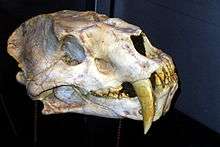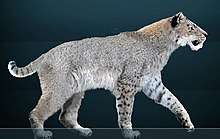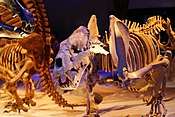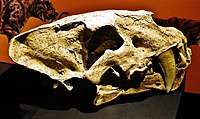Homotherini
Homotherini is an extinct tribe of carnivoran mammals of the family Felidae (true cats). The tribe is commonly known as scimitar-toothed cats. These saber-toothed cats were endemic to North America, Europe, Asia, Africa, and South America[1] from the Miocene to Pleistocene living from c. 23 Ma until c. 12,000 years ago.[2]
| Homotherini | |
|---|---|
| Skeleton of Homotherium serum from Friesenhahn cave, Texas Memorial Museum, University of Texas at Austin, Austin, Texas | |
| Scientific classification | |
| Kingdom: | Animalia |
| Phylum: | Chordata |
| Class: | Mammalia |
| Order: | Carnivora |
| Suborder: | Feliformia |
| Family: | Felidae |
| Subfamily: | †Machairodontinae |
| Tribe: | †Homotherini Fabrini, 1890 |
| Genera | |
Description
Compared to the usually massively built dirk-toothed phenotype, apparent in Smilodon, Megantereon and the feliform Barbourofelis (just to list a few), their upper canines were smaller than those of equally sized cats of that phenotype, but they had serrated edges.[3][4] The scimitar-toothed phenotype has also evolved independently in other mammal families.[5]
Evolution
Based on mitochondrial DNA sequences extracted from fossils, the lineage of Homotherium is estimated to have diverged from that of Smilodon about 18 Ma ago.[6]
The scimitar tooth form was used to assist in the hunting of herbivorous megafauna. With its hyper sharp and serrated form it was perfect for ripping flesh off of downed prey. However, if this tooth would come into contact with bone it could get caught, serrations worn off, or even completely broken thus leaving the organism without a food source, leading to starvation and death.[7][8]
There is a debate about how both the scimitar-tooth and the dirk-tooth evolved in felines and other mammals. the two sides of the debate revolve around whether it was derived from a sexual dimorphic trait or if it was completely natural selection that drove the creation of these phenotypes. The argument for sexual dimorphic origins stems from the fact that in mammals sexual dimorphic traits manifest as tools for males to compete for females. It is believed that the scimitar-tooth and the dirk-tooth were originally only in males for use in competition but then with the rise of mega-herbivores it became favorable for females to take up the trait as well.[9] The natural selection side of the debate argues that the scimitar and dirk-tooth both evolved because of the unfilled niche of predation of megaherbivores so the trait evolved to take advantage of said niche.[10]
Classification
| Genus | Species | Image |
|---|---|---|
| †Amphimachairodus Kretzoi, 1929 |
|
 |
| †Homotherium Fabrini, 1890 |
|
 |
| †Lokotunjailurus Werdelin 2003 |
|
|
| †Nimravides Kitts 1958 |
|
|
| †Xenosmilus Martin et al., 2000 | †X. hodsonae |  |
Phylogeny
The phylogenetic relationships of Homotherini are shown in the following cladogram:[11][12][13][14][15]
| †Homotherini |
| |||||||||||||||||||||||||||||||||||||||||||||||||||||||||||||||||||||||||||
References
- Rincon, A.; Prevosti, F.; Parra, G. (2011). "New saber-toothed cat records (Felidae: Machairodontinae) for the Pleistocene of Venezuela, and the Great American Biotic Interchange". Journal of Vertebrate Paleontology. 31 (2): 468–478. doi:10.1080/02724634.2011.550366.
- Paleobiology Database: Homotherini Basic info.
- Martin, L.D., (1989). Fossil history of the terrestrial Carnivora. In: Gittleman J.L., ed. Carnivore behaviour, ecology, and evolution, Vol. 1. Ithaca, IL: Cornell University Press, 536-568.
- Van Valkenburgh, B (2007). "Deja vu: the evolution of feeding morphologies in the Carnivora". Integrative and Comparative Biology. 47: 147–163. doi:10.1093/icb/icm016. PMID 21672827.
- Meloro, C.; Slater, G. J. (2012). "Covariation in the skull modules of cats: the challenge of growing saber-like canines". Journal of Vertebrate Paleontology. 32: 677–685. doi:10.1080/02724634.2012.649328.
- Paijmans, J. L. A.; Barnett, R.; Gilbert, M. T. P.; Zepeda-Mendoza, M. L.; Reumer, J. W. F.; de Vos, J.; Zazula, G.; Nagel, D.; Baryshnikov, G. F.; Leonard, J. A.; Rohland, N.; Westbury, M. V.; Barlow, A.; Hofreiter, M. (2017-10-19). "Evolutionary History of Saber-Toothed Cats Based on Ancient Mitogenomics". Current Biology. 27: 3330–3336.e5. doi:10.1016/j.cub.2017.09.033. PMID 29056454.
- Van Valkenburgh, B (2007). "Deja vu: the evolution of feeding morphologies in the Carnivora". Integrative and Comparative Biology. 47: 147–163. doi:10.1093/icb/icm016. PMID 21672827.
- Slater, G. J.; Valkenburgh, B. Van (2008). "Long in the tooth: evolution of sabertooth cat cranial shape". Paleobiology. 34: 403–419. doi:10.1666/07061.1.
- Randau, M., C. Carbone, and S. T. Turvey. 2013. Canine evolution in sabretoothed carnivores: natural selection or sexual selection? PLoS ONE 8.
- Van Valkenburgh, B.; Sacco, T. (2002). "Sexual dimorphism, social behavior, and intrasexual competition in large Pleistocene carnivorans". Journal of Vertebrate Paleontology. 22: 164–169. doi:10.1671/0272-4634(2002)022[0164:sdsbai]2.0.co;2.
- "Paleobiology Database". Archived from the original on 2012-03-25. Retrieved 2011-06-16.
- Turner, Alan (1990). "The evolution of the guild of larger terrestrial carnivores during the Plio-Pleistocene in Africa". Geobios. 23 (3): 349–368. doi:10.1016/0016-6995(90)80006-2.
- Martin, L. D.; Babiarz, J. P.; Naples, V. L.; Hearst, J. (2000). "Three Ways To Be a Saber-Toothed Cat". Naturwissenschaften. 87 (1): 41–44. Bibcode:2000NW.....87...41M. doi:10.1007/s001140050007. PMID 10663132.
- Turner, Alan (1997). The Big Cats and their fossil relatives. New York: Columbia University Press. p. 60. ISBN 978-0-231-10228-5.
- Wallace, S. C.; Hulbert, R. C. (2013). Larson, Greger (ed.). "A New Machairodont from the Palmetto Fauna (Early Pliocene) of Florida, with Comments on the Origin of the Smilodontini (Mammalia, Carnivora, Felidae)". PLoS ONE. 8 (3): e56173. Bibcode:2013PLoSO...856173W. doi:10.1371/journal.pone.0056173. PMC 3596359. PMID 23516394.
